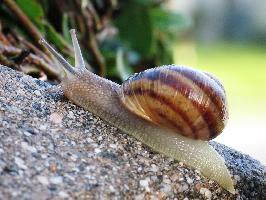
Poids et mesures
| Hauteur au garrot | de 30 à 50 mm |
|---|---|
| Longueur | 10 cm |
| Vitesse | 0,005 km/h |
Description de l'animal
The Roman snail, scientifically known as Helix pomatia, is a terrestrial gastropod mollusk that belongs to the Helicidae family. This species is also commonly referred to as the Burgundy snail, the edible snail, or escargot, a name that hints at its culinary value, particularly in French cuisine. It is native to Europe, with its range extending from the western regions of Germany and the UK to parts of Eastern Europe and the Mediterranean. The Roman snail has also been introduced to other parts of the world, including North America, where it is often considered an invasive species.The Roman snail boasts a robust, spherical shell that can reach up to 4-5 cm in height and about the same in width, making it one of the larger snail species within its habitat. The shell's color varies from light brown to a more yellowish hue, adorned with darker brown bands that spiral around it, though the pattern can vary significantly among individuals. This shell not only serves as a protective barrier against predators and environmental hazards but also plays a crucial role in the snail's moisture retention, which is vital for its survival.
One of the most fascinating aspects of the Roman snail is its hermaphroditic nature, meaning each individual possesses both male and female reproductive organs. Despite this, self-fertilization is rare, and they usually mate with another snail, often engaging in a lengthy and elaborate courtship ritual that can last several hours. This process includes the exchange of a so-called "love dart," a calcareous spike that is believed to increase the chances of reproductive success.
The diet of the Roman snail is primarily herbivorous, feeding on a wide variety of vegetation, including leaves, stems, and flowers, which it grazes at night to minimize desiccation under the sun. Its preference for calcium-rich foods is not only due to nutritional needs but also because calcium is crucial for maintaining its shell's strength and growth.
Roman snails have a slow growth rate and can live for up to 8 years, although their lifespan is often shortened by predation and human harvesting. They are most active during the wet seasons of spring and autumn, and they hibernate during the winter months in soil or under leaves, creating a calcareous epiphragm to seal the shell's opening and conserve moisture.
In terms of ecological impact, the Roman snail contributes to the environment by recycling nutrients through its diet and serving as prey for a variety of predators, including birds, small mammals, and insects. However, its status as an invasive species in some regions has raised concerns about its impact on local ecosystems and native species.
The Roman snail's cultural and economic significance is notable, particularly in European countries where it is farmed and harvested for culinary purposes. Considered a delicacy, the snail is prepared in various gourmet dishes, often cooked with garlic, butter, and parsley. This culinary tradition dates back centuries, highlighting the Roman snail's enduring appeal and importance in human culture.
In conclusion, the Roman snail (Helix pomatia) is a fascinating creature with a complex biology, significant ecological role, and notable cultural and economic value. Its distinctive characteristics and behaviors continue to intrigue scientists, conservationists, and gastronomes alike, making it an important species both in its natural habitat and beyond.
Animaux similaires
Nouvelles photos d'animaux
Top 10 des animaux
- Dolphin gull (Leucophaeus scoresbii)
- Diana monkey (Cercopithecus diana)
- Moustached guenon (Cercopithecus cephus)
- Galápagos tortoise (Geochelone nigra complex)
- Japanese macaque (Macaca fuscata)
- Stone loach (Barbatula barbatula)
- Russian tortoise (Testudo horsfieldii)
- Greek tortoise (Testudo graeca)
- Common flying dragon (Draco volans)
- Vendace (Coregonus albula)
